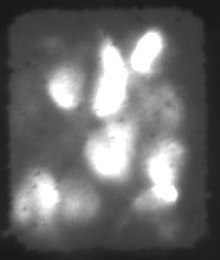
Back شاشة انبعاث مجالي Arabic Field Emission Display Catalan Feldemissionsbildschirm German Field emission display Spanish Luminestsentskuvar Estonian Field Emission Display French Penampil emisi bidang ID Field emission display Italian 電界放出ディスプレイ Japanese 전계 방출 디스플레이 Korean

A field-emission display (FED) is a flat panel display technology that uses large-area field electron emission sources to provide electrons that strike colored phosphor to produce a color image. In a general sense, an FED consists of a matrix of cathode ray tubes, each tube producing a single sub-pixel, grouped in threes to form red-green-blue (RGB) pixels. FEDs combine the advantages of CRTs, namely their high contrast levels and very fast response times, with the packaging advantages of LCD and other flat-panel technologies. They also offer the possibility of requiring less power, about half that of an LCD system. FEDs can also be made transparent.[1]
Sony was the major proponent of the FED design and put considerable research and development effort into the system during the 2000s, planning mass production in 2009.[2] Sony's FED efforts started winding down in 2009, as LCD became the dominant flat-panel technology.[3] In January 2010, AU Optronics announced that it acquired essential FED assets from Sony and intends to continue development of the technology.[4] As of 2023[update], no large-scale commercial FED production has been undertaken.
FEDs are closely related to another developing display technology, the surface-conduction electron-emitter display (SED), differing primarily in details of the electron-emission system.
- ^ "CNT FED". www.teconano.com.tw. Archived from the original on 2019-12-01. Retrieved 2020-01-04.
- ^ "Sony Gets Serious With Another Next-Gen Display Tech: FED, Like CRT But Really Thin". Gizmodo. 5 July 2008.
- ^ Serkan Toto, "FED: Sony calls it quits, basically burying the technology as a whole" Archived 2009-06-19 at the Wayback Machine, CrunchGear, 31 Mar 2009.
- ^ Cite error: The named reference
AUO_FETwas invoked but never defined (see the help page).
© MMXXIII Rich X Search. We shall prevail. All rights reserved. Rich X Search